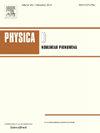Solid-state dewetting of axisymmetric thin film on axisymmetric curved-surface substrates: Modeling and simulation
IF 2.9
3区 数学
Q1 MATHEMATICS, APPLIED
引用次数: 0
Abstract
In this work, we consider the solid-state dewetting of an axisymmetric thin film on a curved-surface substrate, with the assumption that the substrate morphology is also axisymmetric. Under the assumptions of axisymmetry, the surface evolution problem on a curved-surface substrate can be reduced to a curve evolution problem on a static curved substrate. Based on the thermodynamic variation of the anisotropic surface energy, we thoroughly derive a sharp-interface model that is governed by anisotropic surface diffusion, along with appropriate boundary conditions. The continuum system satisfies the laws of energy decay and volume conservation, which motivates the design of a structure-preserving numerical algorithm for simulating the mathematical model. We introduce an arclength parameterization of the generated curve on the axisymmetric curved substrate surface, which plays a crucial role in the subsequent construction of the structure-preserving approximation. By introducing a symmetrized surface energy matrix, we derive a novel symmetrized variational formulation. Then, by carefully discretizing the boundary terms of the variational formulation, we establish an unconditionally energy-stable parametric finite element approximation of the axisymmetric system. By applying an ingenious correction method, we further develop another structure-preserving method that can preserve both the energy stability and volume conservation properties. Finally, we present extensive numerical examples to demonstrate the convergence and structure-preserving properties of our proposed numerical scheme. Additionally, several interesting phenomena are explored, including the migration of ‘small’ particles on a curved-surface substrate generated by curves with positive or negative curvature, pinch-off events, and edge retraction.
轴对称曲面基底上轴对称薄膜的固态脱湿:建模与仿真
在这项工作中,我们考虑了轴对称薄膜在曲面衬底上的固态脱湿,假设衬底形态也是轴对称的。在轴对称假设下,曲面基底上的曲面演化问题可以简化为静态曲面基底上的曲线演化问题。基于各向异性表面能的热力学变化,我们推导了一个由各向异性表面扩散控制的锐界面模型,并给出了适当的边界条件。连续统系统满足能量衰减和体积守恒的规律,这促使设计一种结构保持的数值算法来模拟数学模型。我们在轴对称曲面基底表面上引入了生成曲线的弧长参数化,这对后续构造保结构近似起着至关重要的作用。通过引入对称表面能矩阵,推导出一种新的对称变分公式。然后,通过对变分公式的边界项进行仔细离散,建立了轴对称系统的无条件能量稳定参数有限元近似。通过应用一种巧妙的校正方法,我们进一步开发了另一种既能保持能量稳定性又能保持体积守恒性质的结构保持方法。最后,我们给出了大量的数值例子来证明我们所提出的数值格式的收敛性和保结构性。此外,还探讨了几个有趣的现象,包括由正曲率或负曲率曲线产生的曲面基底上的“小”颗粒的迁移,夹断事件和边缘收缩。
本文章由计算机程序翻译,如有差异,请以英文原文为准。
求助全文
约1分钟内获得全文
求助全文
来源期刊

Physica D: Nonlinear Phenomena
物理-物理:数学物理
CiteScore
7.30
自引率
7.50%
发文量
213
审稿时长
65 days
期刊介绍:
Physica D (Nonlinear Phenomena) publishes research and review articles reporting on experimental and theoretical works, techniques and ideas that advance the understanding of nonlinear phenomena. Topics encompass wave motion in physical, chemical and biological systems; physical or biological phenomena governed by nonlinear field equations, including hydrodynamics and turbulence; pattern formation and cooperative phenomena; instability, bifurcations, chaos, and space-time disorder; integrable/Hamiltonian systems; asymptotic analysis and, more generally, mathematical methods for nonlinear systems.
 求助内容:
求助内容: 应助结果提醒方式:
应助结果提醒方式:


